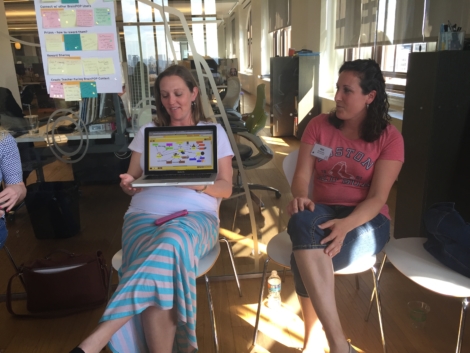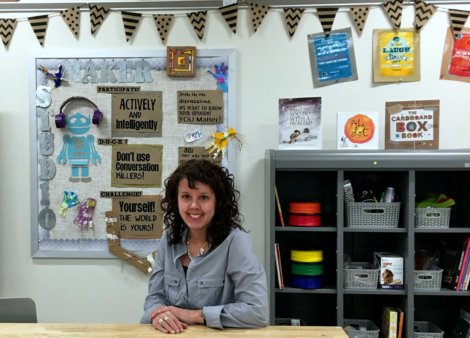
From the mind of a CBE: Top 5 things to love about BrainPOP no matter how old you are!
Posted by Jessica Millstone on
Part Two of December’s Certified BrainPOP Educator of the month series with Nikki Vrandenburg encourages educators to take advantage of all BrainPOP has to offer.
This year I moved across the hall in my school from a K-1 combo room to a 4th-5th combo. As I pushed and shoved my bean bag chairs, my large collection of picture books and my box of Legos across the hall many people wondered if my 4th-5th class would really look that much different than my K-1 class did for twelve years. They were right to wonder. The truth is that if you walked into my new classroom you would notice a few differences, first there is the lovely view of the mountains–which certainly outshines my former parking lot view–but you would also see taller kids working for longer periods of time, reading fatter books and typing essays instead of printing sentences. Other than those things you wouldn’t see many other differences. You would see kids talking excitedly as they built things with cardboard and plastic bottles. You would hear them singing and chanting and using voices to study words and read aloud to one another. You would notice they use markers and crayons as they sit on bean bags, on the floor and on our couch. And you would see them using BrainPOP everyday, throughout the day, in a variety of ways. Here are five things we love about BrainPOP in 4th and 5th grade.
#1 – Moby
All kids love Moby. Andy why not? He’s funny. He beeps. He’s orange. He IS the comic relief to serious topics such as 9/11 and Zika Virus. I knew K-1 kids loved Moby for all of his beeps and silly actions. I was not prepared for how much more the 4-5 kids love him. The difference is they “get” Moby in a way that the K-1’s don’t just yet. They can read his beeps, interpret his gestures and appreciate his gift for physical comedy. The other day I witnessed a fourth grade boy laugh, shake his head and say, “Moby cracks me up!”
#2 – My BrainPOP and Logging in
Obviously this is WAY easier with older kids! It’s even easier if the kids used it last year! And EVEN EASIER if you use Google SSO in a 1:1 chromebook classroom like mine! BrainPOP has worked hard to streamline this process for schools and for that I am incredibly grateful. Logging in took a lot more time and patience in K-1. I can’t say I miss that part!
#3 – GameUp and the SnapThought Tool in Math
Coming from an iPad room to a Chromebook room meant that my students could use GameUp everyday during their math rotations. Moving to 4th/5th meant that the SnapThought tool embedded in GameUp could become a routine for all game play at that time. I teach math in rounds where students rotate in small groups between stations. They meet with me, play a group game from our math curriculum, do an independent page in their math workbooks and play GameUp games. There are days when I give them specific math topics to explore in GameUp or certain games to play; other days, I let them choose. If there is a SnapThought tool icon on the game I ask them to send me some reflections as they play. They write about their strategies or their predictions as they play the game, or sometimes they comment on their mood as they progress through the game. They tell me that they like having this opportunity to reflect or plan their game play. This was never quite doable with the K-1 group. We had other methods for capturing their thinking during games, none of which were as easy and effective as the SnapThought tool.
#4 – Research is still better on BrainPOP
When I was in the K-1 room I had my first graders research a passion topic for Genius Hour projects. BrainPOP was always our go-to source for choosing topics and starting research. The 4-5 kids rely on BrainPOP for research even more than the K-1 students. This is probably because they do more research across all the content areas. Most of my students keep the BrainPOP tab open all the time so they can quickly start using it if they need to. I once overheard a boy tell a classmate who was struggling to find the information she needed for a Science project to “always start with BrainPOP.” Sage words.
#5 – The Meaning of Beep
If you were to visit my class you would most likely hear one or more students ask on a daily basis if they can play “The Meaning of Beep.” This game is new to BrainPOP this year. It is vocabulary building game that allows students to play one another if they are enrolled in a My BrainPOP class. I was lucky to get to demo it at ISTE in the BrainPOP booth so I felt like a pro when I rolled it out for the 4th and 5th graders the first day of school. They were instantly hooked. They love using their own devices to play the game against one another. Many of them quickly figured out how to open a new tab and use an online dictionary to help them find new words for the game. There is also a lot of “Ok, Google, what is a synonym for anonymous?” My word loving heart swells with pride when I hear them working together to find synonyms and pick up on context clues. This game probably would not have been as easy to play in K/1 since success in the game is dependent upon spelling and reading skills. Another win for 4th and 5th grade!
There are lots of differences between my former K/1 classroom life and my new 4th/5th world, but the kids are still just as goofy, creative, and ready to have fun learning as they always were. And Moby is still right in the middle of it all.














